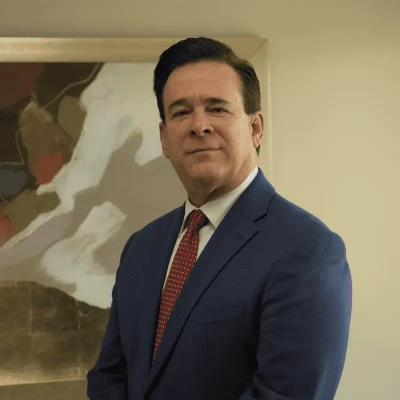How to Collaborate Effectively with Executives in Your Organization
Effective collaboration with executives requires strategic approaches that can transform organizational outcomes. This article offers practical guidance from seasoned executives and leadership experts on building meaningful professional relationships across hierarchical boundaries. The insights presented provide actionable techniques for structured communication, context sharing, and creating environments where candor and collective success can thrive.
Remove Friction Through Structured Communication
Even in a small team like ours, I approach executive communication with the same mindset as user experience: removing friction wherever possible. That means making decisions easy to understand, keeping updates brief but clear, and respecting each person's focus time.
One tip that's worked for me? Default to async, but reserve standing time to talk through anything that needs context. We have a 20-minute weekly check-in where each person brings one thing they're stuck on — it keeps us aligned without drowning in meetings. That small structure has saved us a ton of back-and-forth.
Build Shared Context Before Aligning Goals
My approach to building and managing relationships with other executives is rooted in one principle: shared context before shared goals. Too often, collaboration at the executive level gets reduced to alignment meetings and KPI updates—but real alignment doesn't come from talking about the work, it comes from understanding how each leader thinks about the work.
When I join or collaborate with a leadership team, I make it a priority to learn each executive's decision-making lens—the pressures they face, how they define success, and what keeps them up at night. That understanding builds empathy, and empathy builds trust. Once you know what someone is optimizing for, collaboration stops being political and starts being purposeful.
One tip that's been invaluable is what I call strategic shadowing. Instead of scheduling another cross-functional sync, I'll ask to sit in on an executive's team meeting or planning session, not to contribute, but to observe how they lead. It's one of the fastest ways to spot collaboration gaps and identify where friction comes from. You learn their tempo, their communication style, and how they handle tension—and that insight makes every future interaction smoother and more productive.
This approach has turned potential turf wars into partnerships. For example, what used to be a standoff between marketing and operations over priorities became a shared growth sprint once both sides understood the "why" behind each other's constraints. The collaboration that followed wasn't just more effective—it was faster, because trust had replaced translation.
In short, executives don't need more alignment meetings—they need more shared understanding. When you invest in context, collaboration becomes less about compromise and more about co-creation.
Ground Executive Interactions With Clarity
I mostly like to stick to professional daycare approach.Executives love acting like their pet project is the cure for global famine, so I keep things grounded with clarity. What are we actually trying to do here, and why shouldn't we waste 40 hours arguing over font sizes in a slide deck. Building relationships is less about fake happy hours and more about trust, show up, deliver what you said you would, and resist the urge to monologue like everyone else at the table.
Try become a translator. Execs speak wildly different dialects of Corporate. Finance wants spreadsheets, marketing wants fairy tales, ops wants flowcharts. If you can spin the same point three ways, each one walks away feeling understood instead of sharpening their email daggers for later. Basically, you're subtitles for the Tower of Babel in business casual.

Ask More Questions Than You Answer
I believe building strong executive relationships starts with genuine curiosity about others' perspectives rather than assuming I have all the answers. During leadership meetings and project check-ins, I make it a practice to start conversations with open-ended questions like "What possibilities are you seeing here?" or "How might we tackle this challenge in a new way?" This approach creates space for innovative thinking and signals to my colleagues that their insights are valued. My top collaboration tip is simple but powerful: ask more questions than you answer.

Create Safe Spaces for Genuine Candor
My approach to building relationships with other executives has always centered on something simple but often overlooked—*shared vulnerability*. Early in my career, I thought leadership was about proving you had everything figured out. I'd walk into executive meetings armed with data, ideas, and strategies, but not necessarily openness. The shift came when I realized that true collaboration doesn't start with confidence—it starts with trust.
At Zapiy, I made a conscious effort to create an environment where executives could be honest not just about what's working, but about what's not. I remember one specific instance when we were in the middle of a challenging growth quarter. Tensions were high, and everyone felt the pressure. Instead of launching into problem-solving mode during our leadership meeting, I opened up about the doubts I had about our direction and asked the others where *they* felt uncertain. That simple act changed the tone immediately. The discussion became more real, more productive. People weren't posturing—they were contributing. And out of that came one of our most effective pivots as a company.
Over the years, I've noticed that the best executive relationships aren't built on constant agreement—they're built on mutual respect for each other's perspectives. Every executive brings a different lens, shaped by their discipline. My role, as I see it, is to make sure those lenses align toward a shared goal without losing their individual clarity. That often means asking better questions than giving quick answers and being comfortable with the friction that healthy debate brings.
If I had to share one tip for effective collaboration among executives, it would be this: create a culture where it's safe to be candid. Not performatively transparent, but *genuinely honest*. When leaders can disagree without ego and admit when they don't know something, you move from cooperation to true collaboration.
For me, leadership isn't about managing executives—it's about connecting with them. When the people around you feel seen, trusted, and heard, they don't just execute strategy—they help shape it. And that's where real alignment—and real innovation—begin.
Use Visual Transparency for Strategic Alignment
I've learned that strong executive relationships are built on clarity, respect, and shared vision. At AIScreen, I make it a priority to treat every leadership conversation as a partnership, not a hierarchy. My approach centers on open communication supported by visual transparency—I use internal digital signage dashboards to keep every executive aligned on company goals, performance metrics, and strategic milestones in real time. This shared visibility eliminates silos and encourages honest discussions.
One tip that's been invaluable for effective collaboration is to create structured yet flexible touchpoints. Instead of endless meetings, I hold brief strategy sessions focused on problem-solving, where data from our dashboards guides the discussion. It keeps everyone grounded in facts, not assumptions. The result is a culture of accountability and mutual trust—each executive knows their input directly shapes the bigger picture. Collaboration flows naturally when everyone can literally see progress happening.

Share Context Not Just Results
The best way to build strong relationships with other executives is through transparency. I make it a habit to share both wins and misses early, so there are no surprises later. That builds trust and speeds up problem-solving. One tip for collaboration: communicate context, not just results. When peers understand why decisions are made, it's easier to move fast together
Establish Clear Definitions for Customer Value
I maintain constant contact with other executives to track delivery risks and resource availability and architecture development plans. The approach enables us to prevent unexpected events while maintaining efficient transitions between different teams. I base all my discussions on the common goal of delivering value to customers instead of focusing on technical requirements.
The first step should involve establishing clear definitions for what constitutes completion and the specific quality assessment criteria. The project team achieved better results in the web platform development because they established clear definitions for "done" and quality measurement at the beginning which prevented costly rework during the final stages of development.

Connect Decisions to Broader Business Purpose
When I think about building and managing relationships with other executives, I always start with the belief that collaboration works best when everyone feels their voice has real weight. Over the years, I've worked in industries that move at lightning speed and face constant disruption. In that environment, trust and transparency are everything. I focus on ensuring conversations are grounded in what truly matters to the business, whether that's scaling a new technology, navigating a recycling initiative, or pursuing a sustainability-driven partnership. If we keep the dialogue grounded in both purpose and outcomes, it cuts through noise and builds confidence.
One tip I've learned is to always bring something to the table that connects beyond today's numbers. Executives want to know how the decision before them connects to a broader picture, whether it involves future growth, sustainability commitments, or how a recycling innovation might enhance brand equity. Demonstrating an understanding of not only the financial but also the operational and societal impacts opens the door to stronger partnerships. Collaboration becomes less about defending turf and more about shaping a shared vision, which is the space where the best deals and strategies come alive.

Link Executive Metrics Across Department Lines
Building relationships with other leaders isn't about office politics; it's about sharing the load on the roof. My approach to managing those relationships is to establish shared accountability based on measurable results.
In a roofing company, the sales guy, the office manager, and I are all executives. But if the roof leaks, it's only my neck on the line. The corporate approach is to manage departments separately. My hands-on solution is to make sure every executive has a piece of the job's final quality, not just their own slice of the pie.
A few years ago, we had an issue where the sales team was selling jobs that the production crew couldn't execute profitably. There was a constant friction. I solved it by telling the Sales Director: "Your bonus isn't paid when the contract is signed; it's paid when the client gives us a five-star review, meaning the roof is dry and the yard is clean." I tied his final metric to the work of the production crew and the quality of the cleanup.
This simple act of linking their final results forced a natural collaboration. The Sales Director stopped trying to push sloppy, high-volume jobs and started checking in with the foreman before closing the sale to confirm the scope was solid. He realized that to succeed, he had to secure the perimeter for the production team.
My tip for effective collaboration is: Tie everyone's bonus or final metric to a result that is outside of their immediate department. The best way to manage relationships is to be a person who is committed to a simple, hands-on solution that makes every executive accountable for the integrity of the finished product.
Make Wins Collective Across Teams
I've found that the most effective way to build strong relationships with other executives is through collaborative problem-solving, rather than just meetings or reports. When you're tackling challenges side by side — whether it's improving customer retention or streamlining operations — you build respect naturally because everyone sees each other's strengths in action. It transforms collaboration from a task into a collaborative effort.
One tip I'd share is to make wins collective. When a department achieves a goal, I ensure that credit is shared across teams. Recognizing how each leader's effort contributes to the bigger picture keeps morale high and reinforces that we're all pulling in the same direction. It's amazing how much smoother collaboration becomes when people know their work is valued beyond their own department.

Value Informal Conversations for Hidden Insights
Strong relationships with other executives often develop through intentional informal check-ins, rather than relying only on formal meetings. Early in my role, I scheduled brief monthly coffee meetings with our finance head to discuss his perspective. During one conversation, he shared his frustration about not receiving enough notice to budget for marketing initiatives. This feedback prompted me to provide him with advanced visibility into our campaign calendar, which helped reduce tension and build genuine trust.
I recommend listening for offhand comments during casual interactions, as these often reveal underlying challenges. While formal meetings focus on agendas, informal conversations can highlight real concerns. By recognizing these cues and adjusting your approach, you demonstrate true collaboration and help strengthen professional relationships.
Listen Before Offering Solutions
Early in my career, I learned that strong executive relationships are built by understanding others' perspectives, not just your own. At one point, operations and marketing were misaligned: my team focused on lead generation while the service team struggled with scheduling and staffing. Rather than increasing marketing efforts, I met with our operations lead and observed technicians firsthand to gain a deeper understanding of their challenges. This experience altered my approach to collaboration, demonstrating that effective decisions must align with the realities of daily operations.
I recommend listening carefully before offering solutions. Executives often feel pressure to provide answers, but effective collaboration starts with asking questions and valuing others' expertise. When people feel heard, they are more willing to work toward shared goals. In my experience, this trust-building leads to smoother execution and stronger results.
Anchor Relationships in Shared Operational Metrics
A lot of aspiring leaders think that building executive relationships is a master of a single channel, like socializing or lunch meetings. But that's a huge mistake. A leader's job isn't to be a master of a single function. Their job is to be a master of the entire business.
My approach to building and managing relationships is to anchor every executive relationship in a Shared Operational Metric. This taught me to learn the language of operations. I stop focusing on personal rapport and start focusing on system alignment.
One tip for effective collaboration is to implement "Cross-Functional Operational Vetoes." For example, the Head of Marketing cannot launch a major campaign for OEM Cummins parts without the Operations VP signing off on the logistical capacity. This forces both sides to get out of their "silo" and elevates the conversation to a critical business function.
The collaboration dramatically improves outcomes. I learned that the best personal relationship in the world is a failure if the operations team can't deliver on the promise. The best way to be a leader is to understand every part of the business.
My advice is to stop thinking of relationships as a separate feature. You have to see it as a part of a larger, more complex system. The best leaders are the ones who can speak the language of operations and who can understand the entire business. That's a leader who is positioned for success.

Treat Conversations as Opportunities to Cocreate
Building relationships with other executives has taught me that collaboration starts with understanding, not agenda. Each executive sees the organization through a unique lens finance, operations, marketing, or HR and true alignment only happens when those perspectives are respected. My approach has been to listen first and lead second. Before proposing ideas, I take the time to learn what drives each leader, what pressures they face, and how our goals overlap.
Once trust is built, collaboration becomes natural. I schedule regular one-on-one conversations rather than relying solely on group meetings. These smaller discussions create space for honest dialogue and prevent the disconnect that often appears at higher levels of leadership.
The one tip I would share for effective collaboration is this treat every conversation as an opportunity to co-create rather than convince. When people feel their input shapes the outcome, they take ownership of it. That mindset transforms executive relationships from territorial to cooperative, and decisions become faster, clearer, and more unified.









